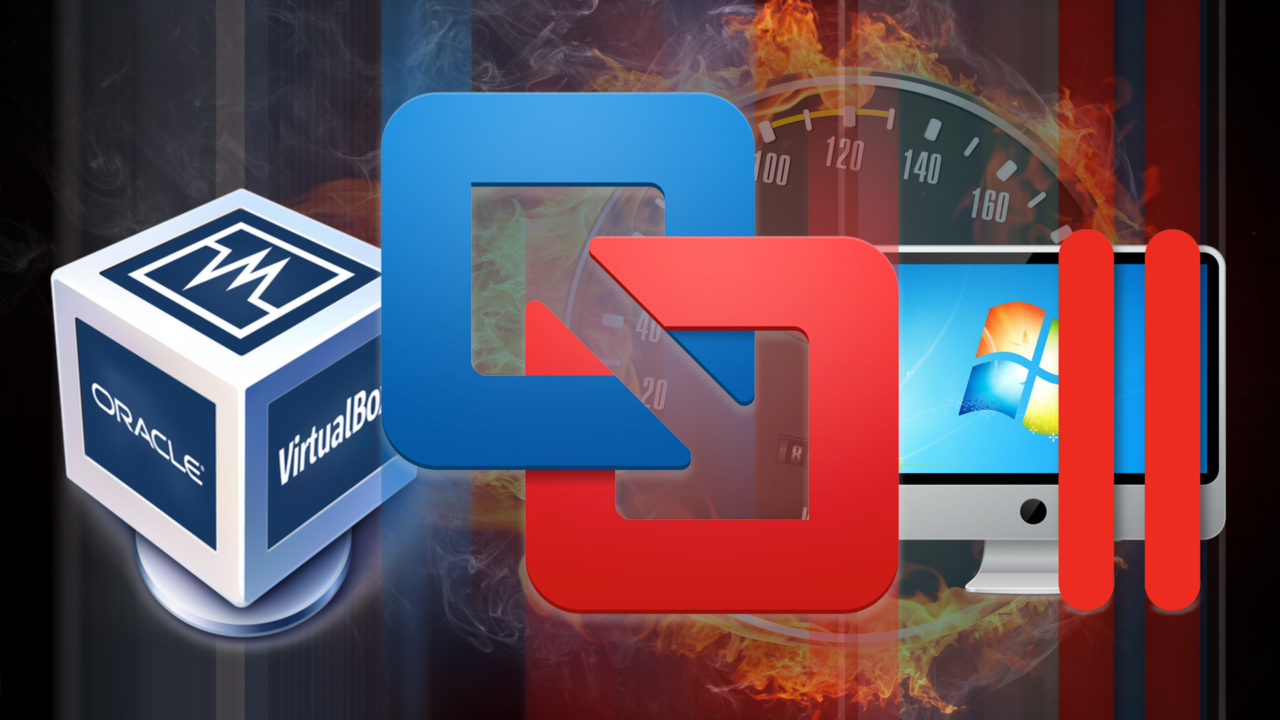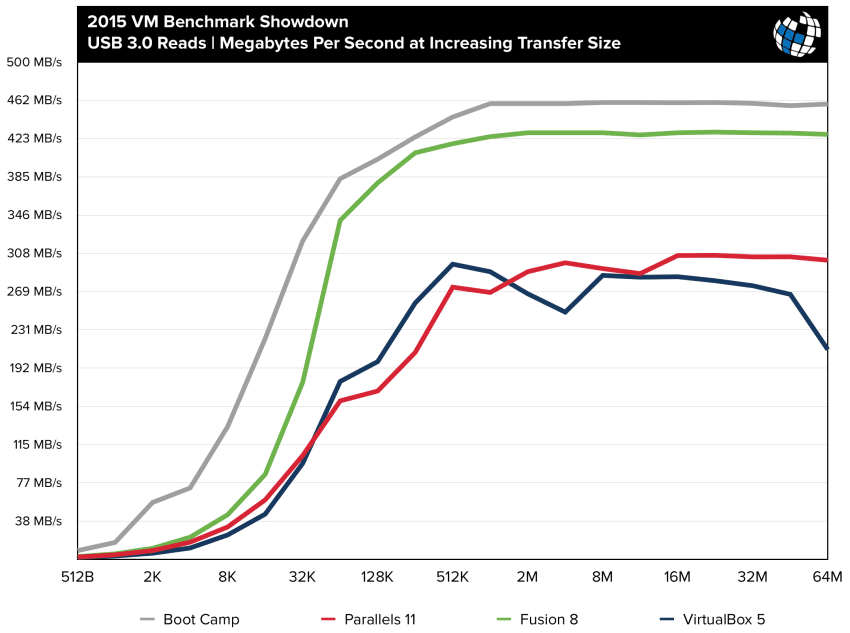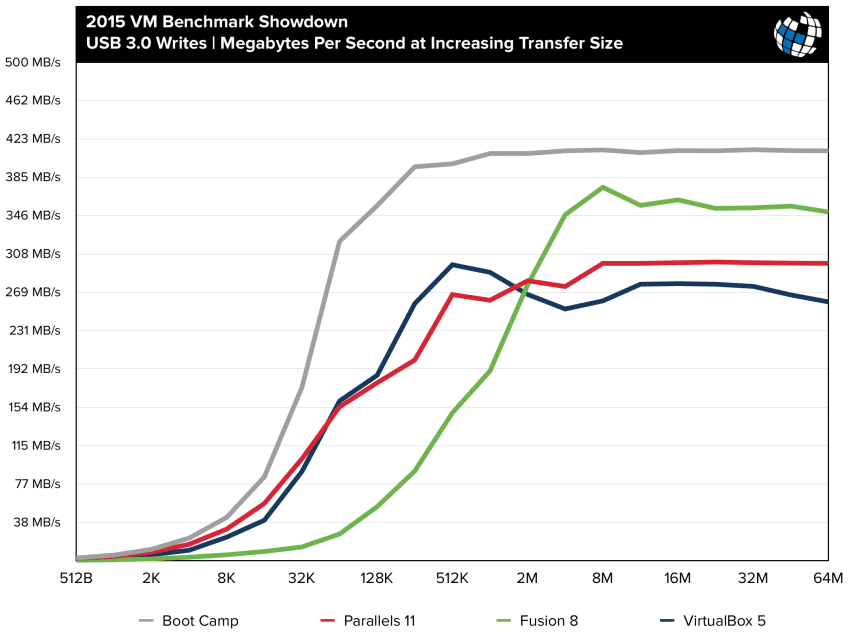2015 VM Benchmarks: Parallels 11 vs. Fusion 8 vs. VirtualBox 5

USB 3.0 Speed
Both Fusion 8 and Parallels 11 support USB 3.0 devices with USB 3.0-compatible host hardware. In theory, this lets the user access their flash drives and external USB hard drives directly from within the VM without a significant loss in speed. But the VM still has to translate the USB 3.0 signal from the host hardware to its own virtual hardware, and there are likely to be performance compromises in that process.
To test just how well our virtual machines could handle USB 3.0 transfers, we used a 1TB Samsung 850 Pro SSD and connected it to our test setup via the StarTech USB 3.1 Single-Bay Dock (our MacBook Pro does not have USB 3.1 support, but the dock is fully backwards-compatible with USB 3.0 devices). With a theoretical bandwidth limit of 5Gbps (and a real-world limit even lower), no USB 3.0 interface can accommodate the full speed of our Samsung SSD. Therefore, this isn’t a test of the maximum speed of the SSD itself, but rather a comparative test of how fast each virtual machine can perform sequential read and write operations.
We used ATTO Disk Benchmark to measure transfer speed in megabytes per second at transfer sizes between 512 bytes and 64 megabytes. A higher number on the y-axis indicates faster speed. To give us a baseline result, we also tested this setup natively via Boot Camp. First up is read performance:
Natively via Boot Camp, we achieved maximum USB 3.0 speeds of about 460MB/s. Of our virtualization platforms, Fusion 8 clearly wins on USB 3.0 reads, coming in not far behind Boot Camp with max speeds of about 425MB/s. VirtualBox surprisingly holds its own in this race, offering similar performance to Parallels 11, albeit with a performance drop-off at the largest transfer sizes.
USB 3.0 write performance is a little more complicated. Boot Camp gives us a performance baseline of around 420MB/s, and Fusion 8 achieves the best speed at large transfer sizes of about 350MB/s, but both Parallels 11 and VirtualBox offer faster speeds at small transfer sizes, with the tipping point right around 2MB/s. Therefore, if you need your VM to transfer lots of small files like text documents and spreadsheets to an external USB 3.0 device, you may see better performance with Parallels (or VirtualBox), but for large files like movies and games, Fusion 8 will be your better option.
Table of Contents
[one_half padding=”0 5px 20px 0″]
1. Introduction
2. Test Setup & Methodology
3. Geekbench
4. 3DMark
5. FurMark OpenGL
6. Cinebench R15
7. PCMark 8
8. Passmark PerformanceTest
[/one_half]
[one_half_last padding=”0 0px 20px 5px”]
9. Video Encoding
10. File Transfers
11. USB 3.0 Speed
12. Virtual Machine Management
13. Battery Life
14. Mac Pro: Gaming
15. Mac Pro: CPU
16. Conclusions
[/one_half_last]



















28 thoughts on “2015 VM Benchmarks: Parallels 11 vs. Fusion 8 vs. VirtualBox 5”
* ESXi with macOS guest
Has anyone else notices that Fusion runs a bit “hotter” than Parallels? I find that opening up Fusion to Win 7 or Win 10 automatically gets the temp up at least 20 degrees (F) or so on my rMBP (2015) set for 2 of 4 cores and 8 of 16 gigs of the RAM allocated. This is very disappointing. I have zero issue with the VMware offering (used it years ago) save for this need to use more energy than Parallels. I only use Windows for a couple of apps but I would be worried about adding a more CPU intensive app if heat is generated like this at a greater scale.
Any thoughts or confirmation of Fusion running hotter?
On my current setup it seems to take an eternity for the memory on my Windows VM to be filled with all the data it needs (I need to have a SQL server and a related application running on my Windows OS). Are there any good metrics on how long it takes for the OS to load up files from the drive into memory?
PS: Hard drive is a traditional drive, system report describes as APPLE HDD ST1000DM003
1) The exact models and specifications for the testing hardware are listed in the article, along with the methodology used for the tests. You’ll find this information on the ironically named “Test Setup & Methodology” page.
2) We submitted our results and methodology to both Parallels and VMware to give each company a chance to respond. Neither company claimed that our testing procedure or the configuration of our virtual machines were incorrect or unfair.
3) Other than providing licenses for both Fusion 8 and Parallels Desktop 11 for our tests, TekRevue was not remunerated by either company in any way, nor were the tests conducted or guided by anyone outside of TekRevue.
4) These products, and our review, are primarily targeted at consumers. That’s why we used both a MacBook Pro and mid-level Mac Pro in the tests. If you’d like us to conduct future tests on your custom Mac Pro (I say “custom” because the Mac Pro you describe in your other comment — 2 x 6-core hyperthreaded 3.33GHz — is not a configuration Apple ever shipped), then please send it to us and we’ll be happy to do the additional testing. In general, however, I hope you’ll agree that your specific configuration isn’t applicable to ~99% of users.
I didn’t try any hard-core games, as I don’t use the machine for that purpose. However, multiple version of Windows (XP, 7, 10) ran faster and smoother overall in Parallels for general use in my experience.
Having said that, I had some trouble with Parallels recognizing certain USB devices that Fusion did not have trouble with. Complained about it to Parallels, and they’ve recently pushed out a new release that addressed and fix those problems, so I appreciate their customer support.
Good article, thanks!
VM Capabilities
VM Capabilities
You are forgetting one major thing: Fusion and Parallels are designed to integrate Windows with OS X. VirtualBox is designed to virtualise an entire machine as if it were 100% separate, no integration at all.
It would be worth seeing how Parallels & Fusion (or even Virtualbox, but I assume it’ll look absolutely terrible as far as performance goes) similarly act under a multi-chip host environment to see how they negotiate allocations between multiple physical chips, as opposed to threads all being sent to the same chip.
I’m an enthusiast of fusion 8 and a user fro version 5. This last release is a great goal!
Overall content on Tekrevue is very solid. I enjoy reading OS X tips mostly.
Thanks guys!:)